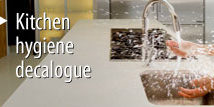1. Shopping, the first step toward trust
Examine the shop:
– Cleanliness of the establishment and personnel
– Products which need to be refrigerated or frozen are properly stored
Examine the product:
– That the external appearance of the food is good
– That packages are in perfect condition
– That the label contains all information regarding ingredients, category, weight, storage conditions, expiry date, etc.
2. Don’t interrupt the cold chain
Buy the refrigerated and frozen products last and carry them in special bags to prevent thawing. Store them in the freezer or refrigerator shelf as soon as possible.
3. Give your fridge some space to breathe!
Do not pack the refrigerator too much. Keep it clean and in perfect operating condition to ensure safe temperatures. Keep food in covered containers. Place cooked products on the top shelves and raw foods on the bottom shelves to avoid possible contamination.
4. Clean, package, label and freeze!
Clean: before freezing, clean food and throw away inedible parts
Package and label: place the food in airtight containers with a label (image of label with food stored, freezing date, no. of rations)
Freeze: Freezing should be quick. Check your freezer’s power.
5. Thaw with care!
The safest way to defrost is in the refrigerator. Vegetables can be thawed directly in boiling water. Consume thawed food within 24 hours and do not refreeze.
6. Fresh food does not mean clean food
Carefully clean foods eaten raw such as vegetables.
When preparing cold sauces such as mayonnaise, take special hygiene precautions, keeping them refrigerated and consuming them as soon as possible.
Dishes prepared with heat but eaten cold such as custard or pastry cream are also considered potentially risky.
7. Fighting germs while cooking
Cooking at high temperatures (frying, baking, stewing, etc.) is almost always an effective sanitation method.
If the food is not going to be eaten immediately, keep cooked food hot or cold, avoiding lukewarm temperatures, and for a very short period of time. Otherwise freeze it.
8. No bacteria crossings
Microorganisms pass from one food to another through contaminated utensils or surfaces, a process called cross-contamination, the most common cause of food poisoning. Clean utensils and surfaces each time you manipulate a different food and remember that your hands are a utensil like any other.
9. Treat your hands as one more utensil
Do not forget that you can also contaminate food; be careful with your personal hygiene. Your awareness and attitude is the key to avoiding food poisoning.
10. Your kitchen: a great ally
The design of your kitchen can help improve hygiene conditions. Kitchen elements must allow forward-facing cleaning, storing, manipulating and serving to avoid recontaminating food. Remember that there are materials, cleaning products and even household appliances that feature antibacterial substances.
